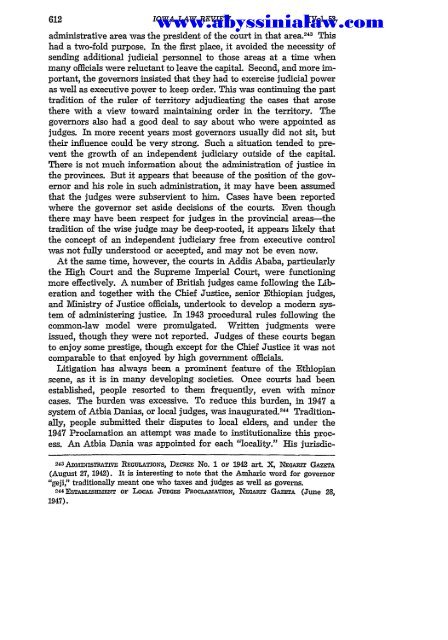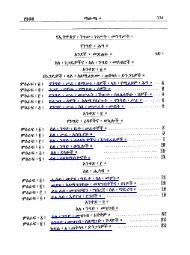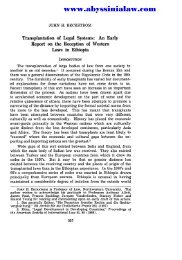Create successful ePaper yourself
Turn your PDF publications into a flip-book with our unique Google optimized e-Paper software.
IOWA LAW REVIEW<br />
administrative area was the president of the court in that area. 243 This<br />
had a two-fold purpose. In the first place, it avoided the necessity of<br />
sending additional judicial personnel to those areas at a time when<br />
many officials were reluctant to leave the capital. Second, and more important,<br />
the governors insisted that they had to exercise judicial power<br />
as well as executive power to keep order. This was continuing the past<br />
tradition of the ruler of territory adjudicating the cases that arose<br />
there with a view toward maintaining order in the territory. The<br />
governors also had a good deal to say about who were appointed as<br />
judges. In more recent years most governors usually did not sit, but<br />
their influence could be very strong. Such a situation tended to prevent<br />
the growth of an independent judiciary outside of the capital.<br />
There is not much information about the administration of justice in<br />
the provinces. But it appears that because of the position of the governor<br />
and his role in such administration, it may have been assumed<br />
that the judges were subservient to him. Cases have been reported<br />
where the governor set aside decisions of the courts. Even though<br />
there may have been respect for judges in the provincial areas-the<br />
tradition of the wise judge may be deep-rooted, it appears likely that<br />
the concept of an independent judiciary free from executive control<br />
was not fully understood or accepted, and may not be even now.<br />
At the same time, however, the courts in Addis Ababa, particularly<br />
the High Court and the Supreme Imperial Court, were functioning<br />
more effectively. A number of British judges came following the Liberation<br />
and together with the Chief Justice, senior Ethiopian judges,<br />
and Ministry of Justice officials, undertook to develop a modern system<br />
of administering justice. In 1943 procedural rules following the<br />
common-law model were promulgated. Written judgments were<br />
issued, though they were not reported. Judges of these courts began<br />
to enjoy some prestige, though except for the Chief Justice it was not<br />
comparable to that enjoyed by high government officials.<br />
Litigation has always been a prominent feature of the Ethiopian<br />
scene, as it is in many developing societies. Once courts had been<br />
established, people resorted to them frequently, even with minor<br />
cases. The burden was excessive. To reduce this burden, in 1947 a<br />
system of Atbia Danias, or local judges, was inaugurated.144 [Vol5<br />
www.abyssinialaw.com<br />
Traditionally,<br />
people submitted their disputes to local elders, and under the<br />
1947 Proclamation an attempt was made to institutionalize this process.<br />
An Atbia Dania was appointed for each "locality." His jurisdic-<br />
243 ADLDIINISTRATIVE REGULATIONS, DECREE No. 1 or 1942 art. X, NEGA GAZ=rA<br />
(August 27, 1942). It is interesting to note that the Amharic word for governor<br />
"geji," traditionally meant one who taxes and judges as well as governs.<br />
244 ESTABLISHMNT or LocAL JUDGES PROCLAmATION, NEGAlUT GAZETA (June 28,<br />
1947).





